Science Olympiad Model Test Paper - 3 | Science Olympiad for Class 3 PDF Download
Note: The questions provided in this document are similar to the questions that were asked in the actual Olympiad exam. So, we recommend you study these for your Olympiad preparation.
Logical Reasoning Section
Q1: There are 25 boats. If each boat can hold 30 people. How many people in total do all the boats hold?
(a) 750
(b) 700
(c) 850
(d) 800
 View Answer
View Answer 
Ans: (a)
Number of boats = 25
Number of people held by 1 boat = 30
Total people in all boats = 25 × 30 = 750 people.
Q2: Estimate the weight of a butterfly.
(a) 30 g
(b) 40 g
(c) 50 g
(d) 10 g
 View Answer
View Answer 
Ans: (d)
The weight of a butterfly around 10 g.
Q3: How many straight lines are there in the diagram given below.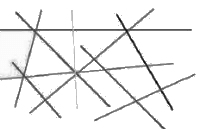
(a) 9
(b) 12
(c) 15
(d) 17
 View Answer
View Answer 
Ans: (a)
There are total 9 straight lines in the given diagram.
Q4: Find the x and y in the given number pattern below.
(a) 36,24
(b) 49,24
(c) 25,24
(d) 16,24
 View Answer
View Answer 
Ans: (b)
The pattern is as follows
Q5: Identify the relation between the given pair of either side of : : and find the missing term.
2 × 3 × 2 : 12 : : 3 × 4 × 3 : ?
(a) 13
(b) 9
(c) 12
(d) 36
 View Answer
View Answer 
Ans: (d)
As, 2 × 3 × 2 = 12
Then, 3 × 4 × 3 = 36
Science Section
Q6: Refer to the given figure. Which of the following can P be?  (a) Oxygen
(a) Oxygen
(b) Water vapour
(c) Nitrogen
(d) Both (a) and (b)
 View Answer
View Answer 
Ans: (d)
Oxygen and water vapour are exchanged through stomata or tiny pores present on the leaf.
Q7: Refer to the given classification table and select the option which correctly identifies X, Y and Z.

 View Answer
View Answer 
Ans: (c)
Spruce is a plant of hilly areas, coconut is a plant of coastal areas, and date palm is a plant of desert areas.
Q8: Given is a description of a plant.
I am a land plant.
I have flowers which grow singly.
My flowers give off a nice smell.
Which one of the following is the plant likely to be?
(a) Rose
(b) Lotus
(c) Dahlia
(d) Sunflower
 View Answer
View Answer 
Ans: (a)
Lotus is an aquatic plant. Dahlia and Lotus grow singly but the flowers do not have nice smell. So, rose is the correct option.
Q9: Which of these functions is not performed by the roots of the plant?
(a) Absorb nutrients from the soil
(b) Absorb water from the soil
(c) Prepare food for the plant
(d) Tie the plant to the ground
 View Answer
View Answer 
Ans: (c)
The food is prepared by leaves of the plant.
Q10: Starting from the first letter, strike out every alternate letter in the given letter group to find out the name of an animal.
K M T O J S N Q S U P I T T O O P
Now, select the option which correctly describes how this animal eats its food.
(a) Lapping
(b) Swallowing
(c) Chewing
(d) Sucking
 View Answer
View Answer 
Ans: (d)
- To find the animal's name, we take the letters K M T O J S N Q S U P I T T O O P and remove every alternate letter, starting from the first. This gives us the letters O, J, S, Q, U, T, O, O, which spells "octopus".
- Octopuses are known for their unique way of eating, which involves using their tentacles to bring food to their mouths.
- The correct option that describes how an octopus eats is sucking, as they use their beak to suck in food.
- Thus, the answer is (d) Sucking, as it accurately describes the feeding method of the octopus.
Q11: Read these statements and choose the correct option.
Statement A : The study of plants is branch of Chemistry.
Statement B : There is a natural element in bananas that makes the eater sad.
(a) Statement A is true
(b) Statement B is true
(c) Both statements A and B are true
(d) Both statements A and B are false
 View Answer
View Answer 
Ans: (d)
The study of plants is a branch of Biology.
Q12: Select the INCORRECT statement.
(a) Our ribcage protects the heart.
(b) Kidneys help to remove waste from the body.
(c) Complete digestion of food takes place in the stomach.
(d) Spinal cord is a part of the nervous system.
 View Answer
View Answer 
Ans: (c)
- Complete digestion of food does not occur in the stomach; it mainly happens in the small intestine.
- The stomach is responsible for breaking down food and mixing it with digestive juices, but it does not fully digest it.
- The small intestine is where most nutrients are absorbed and where the final stages of digestion occur.
- Therefore, option (c) is the incorrect statement among the choices provided.
Q13: Select the option that accurately matches a planet with a constellation.
(a) Neptune, Moon
(b) Jupiter, Orion
(c) Mars, Uranus
(d) Sun, Scorpius
 View Answer
View Answer 
Ans: (b)
- Jupiter is a planet that is often associated with the constellation Orion in various astronomical contexts.
- The other options do not correctly pair a planet with a recognized constellation.
- For example, Neptune is not paired with the Moon, and the Sun is not a planet but a star.
- Thus, the correct pairing is Jupiter with Orion.
Q14: __________ is a standard unit for measuring length.
(a) Handspan
(b) Cubit
(c) Footspan
(d) Metre
 View Answer
View Answer 
Ans: (d)
- Metre is the internationally accepted unit for measuring length, widely used in science and everyday life.
- Other options like Handspan, Cubit, and Footspan are traditional units but not standardized.
- The metre is part of the metric system, making it easier to use in calculations and conversions.
- Understanding the metre helps in various fields, including engineering, construction, and education.
Q15: In which of these plants are stomata present on the upper surface of the leaf?
(a) Floating plants
(b) Land plants
(c) Desert plants
(d) Aerial plants
 View Answer
View Answer 
Ans: (a)
This helps in top layer of the leaf to exchange gases as the bottom layer is covered with water.
Q16: Study the Venn diagram and identify X. (a) Fern
(a) Fern
(b) Dodder
(c) Hydrilla
(d) Pitcher plant
 View Answer
View Answer 
Ans: (d)
Pitcher plant is a green plant and makes its own food.
Q17: Study the given figure. Which plant part(s) has/have been INCORRECTLY matched with the function?

(a) X only
(b) X and Z
(c) Y only
(d) Y and Z
 View Answer
View Answer 
Ans: (c)
Leaves (X) make food for the plant. Roots (Z) absorbs water for the plant. Stems (Y) do not hold the plant firmly to the ground. This is also the function of roots (Z). The stem (Y) provides structure to the plant.
Q18: Study the following types of roots.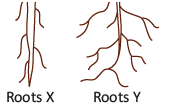 In what way(s) do roots Y have an advantage over roots X?
In what way(s) do roots Y have an advantage over roots X?
(A) They can trap more sunlight.
(B) They can hold the plant more firmly in the soil.
(C) They can absorb water from a greater area of the soil.
(D) They can transport more food to the other parts of the plant.
(a) D only
(b) B and C only
(c) B, C and D only
(d) A, B, C and D
 View Answer
View Answer 
Ans: (b)
The roots are not responsible for trapping sunlight and the roots do not supply food to other parts of the plant. It is the function of the leaves.
Q19: The bird whose foot is shown in the given figure is a _________ bird. (a) Swimming
(a) Swimming
(b) Perching
(c) Scratching
(d) Wading
 View Answer
View Answer 
Ans: (a)
- Swimming birds have webbed feet, which are ideal for moving through water.
- These birds are adapted to aquatic environments, making them efficient swimmers.
- Examples include ducks and swans, which use their feet to paddle in water.
- The foot structure shown in the figure likely indicates a bird that is designed for swimming.
Q20: Select the correct match.
(a) Mimicry - Hawk, moth, caterpillar
(b) Aestivation - Polar bear
(c) Blubber - Cow
(d) Blowhole - Fish
 View Answer
View Answer 
Ans: (a)
Aestivation is summer sleep, polar bears sleep or hibernate in winters, blubber is found in large sea animals, not in cows and Blowhole is an animal organ in (a type of whale)
Q21: Study the two life cycles P and Q and select the option that correctly identifies the organism which shows these cycles respectively.

 View Answer
View Answer 
Ans: (c)
Life cycle of housefly develops in four stages and life cycle of cockroach comprises of three developmental stages.
Q22: Refer to the given flowchart and select the correct option regarding P, Q, R and S.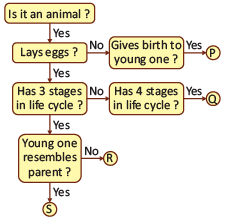 (a) P could be duck-billed platypus or spiny ant eater.
(a) P could be duck-billed platypus or spiny ant eater.
(b) Q exhibits one non-feeding stages in its life cycle.
(c) R could be frog or hen
(d) All the stages of life cycle of S are feeding and S could be beetle or botfly.
 View Answer
View Answer 
Ans: (b)
Q has 4 stages in its life cycle including pupa which is a non-feeding stage.
Q23: Read the given statements and select the INCORRECT one.
(a) Kutcha houses are made by using mud, wood, straw, etc.
(b) A good house must have enough windows to let in fresh air and sunlight.
(c) Natural fibers like linen and silk are obtained from plants only.
(d) Fibers obtained from sheep and yak are suitable for making clothes that are worn in winter season.
 View Answer
View Answer 
Ans: (c)
- Natural fibers can come from both plants and animals. While linen and silk are indeed natural fibers, silk is derived from silkworms, which are animals, not plants.
- Options (a), (b), and (d) are correct statements about housing materials and the properties of fibers.
- Thus, the statement that natural fibers like linen and silk are obtained from plants only is incorrect.
Q24: Refer to the given flowchart. Identify P to U and select the INCORRECT statement regarding them.
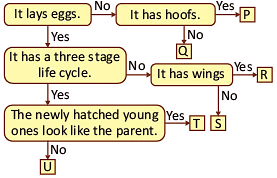 (a) Q could be a wild animal that lives in a den whereas P could be a domestic animal that lives in a shed.
(a) Q could be a wild animal that lives in a den whereas P could be a domestic animal that lives in a shed.
(b) Both R and S could have six-jointed legs.
(c) T could breathe spiracles whereas U could breathe through moist skin.
(d) P and S could be cold-blooded animals whereas R and T could be warm-blooded animals.
 View Answer
View Answer 
Ans: (d)
P and S could be coldblooded animals whereas R and T could be warm-blooded animals.
Q25: Refer to what Mora is saying and select the correct option regarding it?
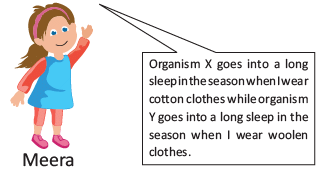 (a) Organism X can be hibernating animal like penguin.
(a) Organism X can be hibernating animal like penguin.
(b) Organism Y can be an aestivating animal like Arctic fox.
(c) Organism X can be an aestivating animal like cockroach.
(d) Organism Y can be a hibernating animal like lizard.
 View Answer
View Answer 
Ans: (d)
Hibernation takes place in winters and Aestivation takes place in summers.
Q26: Satvik listed four birds namely crow, sparrow, hen and vulture, together in the same group. But, his friends argued that one bird is an odd one in the group and gave different reasons for this. Which of these friends argued correctly?
(a) Mayank – Sparrow is a herbivore unlike others.
(b) Nishant – Vulture is a carnivore unlike others.
(c) Sarthak – Crow is a carnivore unlike others.
(d) Both (a) and (b)
 View Answer
View Answer 
Ans: (b)
Vulture is a carnivore while hen and crow eat seeds also like sparrow.
Q27: Which of these animals is described in the given box?
 (a) Lizard
(a) Lizard
(b) Pigeon
(c) Frog
(d) Moth
 View Answer
View Answer 
Ans: (a)
Only lizard of these has scaly skin.
Q28: Which of the following statements are INCORRECT?
(i) Whales and dolphins breathe through gills as they are aquatic animals.
(ii) Warm-blooded animals have the same temperature inside their body all the time.
(iii) Elephants can trick their enemies by camouflaging.
(iv) Parasites feed on the flesh of dead animals.
(a) (i) and (iii)
(b) (ii), (iii) and (iv)
(c) (i), (iii) and (iv)
(d) (i), (ii) and (iii)
 View Answer
View Answer 
Ans: (c)
Whales and dolphins breathe through lungs, Elephants cannot camouflage, parasites feed on the body of hosts.
Q29: Which of the following is NOT a microorganism?
(a) Bacteria
(b) Virus
(c) Fungus
(d) Larva
 View Answer
View Answer 
Ans: (d)
Larva is a stage in life cycle of many animals that undergo metamorphosis.
Q30: Which of the following statements about mammals is correct?
(a) Mammals have hair on their body
(b) Mammals give birth to young ones
(c) Mammals produce milk
(d) All of these
 View Answer
View Answer 
Ans: (d)
All the statements are correct about mammals.
Achiever’s Section
Q31: Which of the following plants have very thin and weak stems, and requires support to grow?
(a) Coriander
(b) Money plant
(c) Potato
(d) Beetroot
 View Answer
View Answer 
Ans: (b)
The money plant has weak stems and relies on external support to grow, unlike coriander, potato, and beetroot, which do not require support.
Q32: Why is the Sun important to the Earth?
1. It provides light energy to green plants to make their own food.
2. It provides heat that enables living things to survive on Earth.
3. It rotates around the Earth to give us seasons.
(a) 1 & 2 only
(b) 1 & 3 only
(c) 2 & 3 only
(d) 1, 2 & 3
 View Answer
View Answer 
Ans: (a)
The Sun provides light energy, which is essential for photosynthesis in green plants.
It also provides heat, which makes life possible on Earth.
The Sun does not rotate around the Earth, which is why statement 3 is incorrect.
Q33: Select the INCORRECT statement.
(a) Blue whale is bigger than the largest dinosaur lived on the Earth.
(b) A baby whale is called a cub.
(c) A mother whale feeds milk to its baby under the water
(d) A large whale can eat 1.5 tones of food everyday.
 View Answer
View Answer 
Ans: (b)
The incorrect statement is that a baby whale is called a cub. Baby whales are called calves, not cubs.
Q34: Decrease in temperature changes __________ into _____________.
(a) solids, liquids
(b) liquids, gases
(c) gases, solids
(d) liquids, solids
 View Answer
View Answer 
Ans: (d)
Freezing converts liquids into solids.
Q35: Which of these freezes fastest?
(a) Cold water
(b) Warm water
(c) Hot water
(d) All of these take same time
 View Answer
View Answer 
Ans: (c)
Hot water freezes the fastest due to weak attraction between the molecules.
|
32 videos|86 docs|53 tests
|
FAQs on Science Olympiad Model Test Paper - 3 - Science Olympiad for Class 3
| 1. What topics are covered in the Class 3 Science Olympiad Model Test Paper - 3? |  |
| 2. How can I prepare my child for the Science Olympiad? |  |
| 3. What is the format of the questions in the Science Olympiad Model Test Paper? |  |
| 4. Are there any recommended resources for additional practice? |  |
| 5. What is the importance of participating in the Science Olympiad for Class 3 students? |  |





















